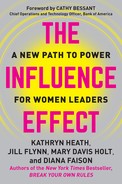Notes
Introduction
1All of the examples in this book are based on stories from the women we coach. Almost all names and places have been changed. If requested by the individual, story details are further masked.
2Kathryn Heath, Jill Flynn, and Mary Davis Holt, “Women, Find Your Voice,” Harvard Business Review, June 2014, https://hbr.org/2014/06/women-find-your-voice.
3Justin Wolfers, “When Teamwork Doesn’t Work,” New York Times, January 8, 2016, http://www.nytimes.com/2016/01/10/upshot/when-teamwork-doesnt-work-for-women.html?emc=eta1.
Chapter 1
Epigraph: The managing editor of Time, Nancy Gibbs, said this in 2014 about the magazine’s “Time 100” list of influential people, published Friday, April 25, 2014. https://en.wikipedia.org/wiki/Time_100#cite_note-6. Accessed June 28, 2017.
1“Women CEOs of the S&P 500,” Catalyst, April 25, 2017, http://www.catalyst.org/knowledge/women-ceos-sp-500.
2“Pyramid: Women in S&P 500 Companies,” Catalyst, March 1, 2017, http://www.catalyst.org/knowledge/women-sp-500-companies.
3Gillian Tett, “The Dearth of Women in the Tech World Is Cultural and Therefore Entirely Reversible,” Chicago Tribune, March 20, 2017, http://www.chicagotribune.com/news/sns-wp-tech-comment-8b1716f0-0d7e-11e7-9d5a-a83e627dc120-20170320-story.html.
4Elena Kvochko, “Why There Are Still Few Women Leaders in Tech,” Forbes, January 4, 2016, https://www.forbes.com/sites/elenakvochko/2016/01/04/women-executives-in-tech/#6317ea1155e7.
5“Quick Take: Women in Academia,” Catalyst, July 9, 2015, http://www.catalyst.org/knowledge/women-academia.
Chapter 2
Epigraph: Mary Oliver, New and Selected Poems (Boston: Beacon Press, 1992), 94.
1Herminia Ibarra and Otilia Obodaru, “Women and the Vision Thing,” Harvard Business Review, January 2009, https://hbr.org/2009/01/women-and-the-vision-thing.
2Liz Ryan, “How to Explain Why You Left a Toxic Workplace,” Forbes, October 18, 2016, http://www.forbes.com/sites/lizryan/2016/10/18/how-to-explain-why-you-left-a-toxic-workplace/#1a3803548bf3.
3Pauline Rose Clance and Suzanne Ament Imes, “The Imposter Phenomenon in High Achieving Women: Dynamics and Therapeutic Intervention,” Psychotherapy Theory, Research and Practice 15, no. 3 (1978): 241–47.
4Susan Pinker, The Sexual Paradox: Troubled Boys, Gifted Girls and the Real Difference between the Sexes (New York: Scribner, 2008), 184–96.
5Satoshi Kanazawa and Kaja Perina, “Why Do So Many Women Experience the ‘Imposter Syndrome’?” Scientific Fundamentalist (blog), December 13, 2009, http://www.psychologytoday.com/blog/the-scientific-fundamentalist/200912/why-do-so-many-women-experience-the-imposter-syndrome.
6Ibid.
Chapter 3
Epigraph: This lyrical adage is an often referenced Kenyan proverb.
1“Pyramid: Women in S&P 500 Companies,” Catalyst, March 1, 2017, http://www.catalyst.org/knowledge/women-sp-500-companies.
2LeanIn.org and McKinsey, Women in the Workplace, 2016, extract, September 2016, http://www.mckinsey.com/business-functions/organization/our-insights/women-in-the-workplace-2016.
3Sylvia Ann Hewlett, “Constructing Your Career Castle,” Harvard Business Review, August 27, 2013, https://hbr.org/2013/08/constructing-your-career-castl.
4Diane Reay, “Spice Girls, ‘Nice Girls’, ‘Girlies’ and Tomboys: Gender Discourses, Girls’ Cultures and Femininities in the Primary Classroom,” Gender and Education 13, no. 2 (2001): 153–66.
5Rachel Croson and Uri Gneezy, “Gender Differences in Preferences,” Journal of Economic Literature 47, no. 2 (June 2009): 448–74.
6Herminia Ibarra, “Women Are Over-Mentored (but Under-Sponsored),” interview by Julia Kirby, HBR IdeaCast, August 2010, https://hbr.org/2010/08/women-are-over-mentored-but-un.
7Herminia Ibarra, Nancy M. Carter, and Christine Silva, “Why Men Still Get More Promotions than Women,” Harvard Business Review, September 2010, https://hbr.org/2010/09/why-men-still-get-more-promotions-than-women?referral=00134.
8Sylvia Ann Hewlett, “The Right Way to Find a Career Sponsor,” Harvard Business Review, September 11, 2013, https://hbr.org/2013/09/the-right-way-to-find-a-career-sponsor.
9Sylvia Ann Hewlett, Forget a Mentor, Find a Sponsor: The New Way to Fast-Track Your Career (Boston: Harvard Business Review Press, 2013).
Chapter 4
Epigraph: Rob Cross and Robert J. Thomas, “A Smarter Way to Network,” Harvard Business Review, July–August 2011, https://hbr.org/2011/07/managing-yourself-a-smarter-way-to-network.
1“Invest in Golf,” Barron’s, March 30, 1998, cover.
2Carol Bartz and Lisa Lambert, “Why Women Should Do Less and Network More,” Fortune, November 11, 2014, http://fortune.com/2014/11/12/why-women-should-do-less-and-network-more/.
Chapter 5
Epigraph: Scott Stratten and Allison Kramer, UnMarketing: Stop Marketing. Start Engaging, 2nd ed. (New York: Wiley, 2016).
1Deborah Tannen, He Said, She Said: Instructor’s Package (Los Angeles: Into the Classroom Media, n.d.), 4, http://www.evgonline.com/Downloads/Hesaidshesaidinstr.guide.pdf.
2Marshall Goldsmith, What Got You Here Won’t Get You There: How Successful People Become Even More Successful (New York: Hachette Books, 2007).
3Linda Babcock and Sara Laschever, “Interesting Statistics,” website for Women Don’t Ask: Negotiation and the Gender Divide (book), accessed May 1, 2017, http://www.womendontask.com/stats.html.
4Stephen R. Covey, The 7 Habits of Highly Effective People Personal Workbook (New York: Touchstone, 2004), 74.
Chapter 6
Epigraph: Maureen Orth, “Angela’s Assets,” Vanity Fair, accessed January 28, 2017, http://www.vanityfair.com/news/2015/01/angela-merkel-profile.
1Roger Martin, The Opposable Mind (Boston: Harvard Business School Press, 2007), 7.
2Ibid.
Chapter 7
Epigraph: Karen Dahut, executive vice president at Booz Allen Hamilton, told us this directly as part of our interview and survey research for this book.
1Dave Kurlan, “Who Are Better Salespeople—Men or Women?,” Understanding the Sales Force (blog), October 22, 2008, http://www.omghub.com/salesdevelopmentblog/tabid/5809/bid/7054/Who-Are-Better-Salespeople-Men-or-Women.aspx.
2Jon Katzenbach, Ilona Steffen, and Caroline Kronley, “Culture Change That Sticks,” Harvard Business Review, July–August 2012, https://hbr.org/2012/07/cultural-change-that-sticks.
3Peter Block, The Empowered Manager: Positive Political Skills at Work (San Francisco: Jossey-Bass, 1987).
Chapter 8
Epigraph: John C. Maxwell, The 21 Irrefutable Laws of Leadership: Follow Them and People Will Follow You, rev. ed. (Nashville: Thomas Nelson, 2007).
1Cambridge Academic Content Dictionary, s.v. “momentum,” http://dictionary.cambridge.org/us/dictionary/english/momentum?q=Momentum.
2Jeanine Prime, Women “Take Care,” Men “Take Charge”: Stereotyping of U.S. Business Leaders Exposed (New York: Catalyst, 2005), 1, http://www.catalyst.org/system/files/Women_Take_Care_Men_Take_Charge_Stereotyping_of_U.S._Business_Leaders_Exposed.pdf.
3Katy Winter, “Secret to Success? Become a Boaster!,” Daily Mail, January 14, 2014, http://www.dailymail.co.uk/femail/article-2539247/Women-feel-modest-holds-work-place.html.
4Lisa J. Marshall and Lucy D. Freedman, Smart Work: The Syntax Guide to Influence, 2nd ed. (Cupertino, CA: Happy About, November 2012).
5“The Toolkit: Blame Frame vs. Aim Frame,” Executive Advisory website, accessed May 6, 2017, http://www.theexecutiveadvisory.com/toolkit/blame_vs_aim.html.
6Zig Ziglar, God’s Way Is Still the Best Way (Nashville: Thomas Nelson, 2007), 46.
7Malcolm Gladwell, The Tipping Point: How Little Things Can Make a Big Difference (New York: Little Brown, 2000), 12.
8Kirsten Helvey, “Don’t Underestimate the Power of Lateral Career Moves for Professional Growth,” Harvard Business Review, May 10, 2016, https://hbr.org/2016/05/dont-underestimate-the-power-of-lateral-career-moves-for-professional-growth.
Chapter 9
1Genie Z. Laborde, Influencing with Integrity: Management Skills for Communication and Negotiation (Palo Alto: Syntony, 1983).
Chapter 10
1Portions of the first half of this chapter are based on a white paper we wrote in 2014 and a Harvard Business Review article published that same year. Kathryn Heath, Jill Flynn, and Mary Davis Holt, Why Meetings Matter Even More for Women (Charlotte, NC: Flynn Heath Holt Leadership, 2014); Kathryn Heath, Jill Flynn, and Mary Davis Holt, “Women, Find Your Voice,” Harvard Business Review, June 2014, https://hbr.org/2014/06/women-find-your-voice.
2Juliet Eilperin, “White House Women Want to Be in the Room Where It Happens,” Washington Post, September 13, 2016, https://www.washingtonpost.com/news/powerpost/wp/2016/09/13/white-house-women-are-now-in-the-room-where-it-happens/?utm_term=.0885ea9fda5d.
